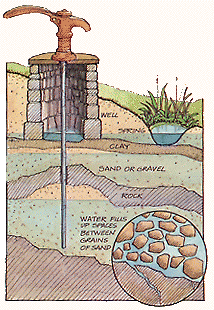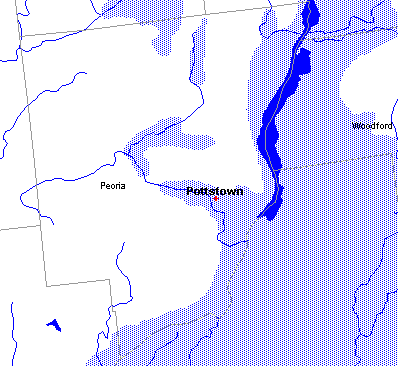There are always two sides to every story, so today we’ll look at PDC’s side of the aquifer question. Here to defend PDC is a surprise advocate: the Peoria Park District.
The mission statement of the Peoria Park District is “To enrich life in our community through stewardship of the environment and through provision of quality recreation and leisure opportunities.” One definition of “stewardship” is “caring for land and associated resources and passing healthy ecosystems to future generations.”
Imagine my surprise when I happened upon this letter from the Park District urging approval of PDC’s landfill expansion. The letter states, in part, “We have served PDC as a supplier over the past several years. It is crucial for the PDC siting application to be approved . . . The economic impact to our organization may be substantial if we cannot count on PDC’s business due to the closure of the PDC No. 1 landfill.”
That raises a couple of questions in my mind. First of all, what is the Park District supplying to PDC? And secondly, why are they in favor of the expansion? I called the park district to ask and got to speak with none other than Parks Director Bonnie Noble herself.
She was an unapologetic advocate for the landfill expansion. In response to my initial question about what the Park District supplies PDC, she said that when they were building the Riverplex, PDC helped them remove and dispose of some underground storage tanks, plus they handle waste from the zoo. Also, PDC provides all the waste receptacles and clean-up for riverfront events.
She went on to state why she wholeheartedly supports the expansion. She feels there is a lot of misinformation being spread by opponents of the landfill. For instance, she disputes the contention that the landfill is located over the Sankoty aquifer. It’s actually over the “Shelbyville outwash,” she contends. I can’t find any independent verification of that, but I’m not a geologist, of course. However, PDC’s application does make a similar distinction:
The Lower Sand [of the local geology] is a side-valley outwash facies of the Sankoty Formation. It is an immature, poorly-sorted, brown, fluvial sand that was deposited by local tributary streams that discharged from the west into the ancestral Mississippi River Valley. The side-vally outwash facies should not be confused with the Sankoty Sand. The Sankoty Sand is a mature, well-sorted, fluvial sand that was deposited directly by the ancestral Mississippi River. The sand grains of the Sankoty Sand are distinctly-pink and uniformly of pure quartz composition . . . The sedimentary bedrock forms an impermeable hydrogeologic basement. The existing PDC No. 1 landfill and the proposed landfill expansion are or will be constructed in the Upper Till. Perched groundwater is discontinuously present in isolated sand lenses within the Upper Till.
The implication seems to be that this “side-valley outwash facies” is a separate entity from the Sankoty aquifer. This portion of PDC’s application is certified by two Illinois-licensed professional geologists who conclude after considerable analysis, “the proposed expansion is favorably designed and located to prevent any adverse impact on the groundwater.”
I hope they’re right.
Noble also took issue with calling the waste PDC received “toxic.” She felt that calling it “toxic waste” played on people’s emotions, and that a more appropriate name would be “hazardous waste.” I won’t argue with her on opponents’ transparent effort to play on people’s emotions. But I don’t think it’s overstating the point to describe this waste as “toxic.” The EPA describes the chemicals PDC takes in as “toxic,” so I have to disagree with Noble on that point.
So, how do I feel about it now? Well, my previous post on this topic was predicated on the belief that the landfill expansion was going to be over the Sankoty, and I was concerned about the increased risk to our drinking water. If the expansion is not over the Sankoty and there is no increased risk, then I guess my primary concern has been answered.
On the other hand, I’m never going to have warm-fuzzy feelings about hazardous waste. And I’m never going to be pleased that we’re accepting this waste from ten other states. But until I hear expert testimony from the other side — say, another licensed geologist or two — I can’t very well just dismiss the opinions of the geologists in PDC’s application.
Overall, I’m in agreement with other commenters who advocate attacking this problem from the supply-side. How can we avoid producing toxic waste in the first place? And what can be done to recycle it instead of burying it? Those are the questions we need to be asking so we can find an ultimate solution to our toxic waste problems.
And I still think it’s weird that the Park District advocates expanding a toxic-waste landfill. Isn’t that kind of like a vegetarian advocating the expansion of Alwan & Sons Meat Company?

 The Peoria County Board took an “initial vote” on the PDC landfill expansion request tonight, and unless some board members change their mind between now and May 3 when they take the final vote, it looks like the application will go down to defeat.
The Peoria County Board took an “initial vote” on the PDC landfill expansion request tonight, and unless some board members change their mind between now and May 3 when they take the final vote, it looks like the application will go down to defeat. I have refrained from commenting on this topic because I had high hopes of wading through the public hearing transcripts, site application, letters recommending passage/denial, etc., etc. But, alas, I simply don’t have the time to do that.
I have refrained from commenting on this topic because I had high hopes of wading through the public hearing transcripts, site application, letters recommending passage/denial, etc., etc. But, alas, I simply don’t have the time to do that. The picture to the left (from the
The picture to the left (from the 